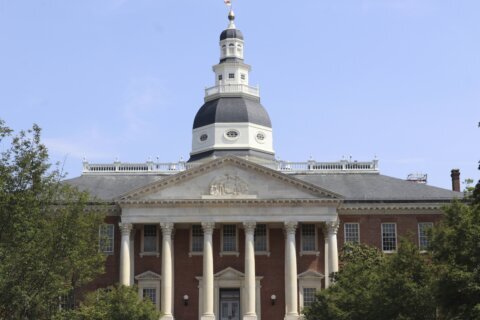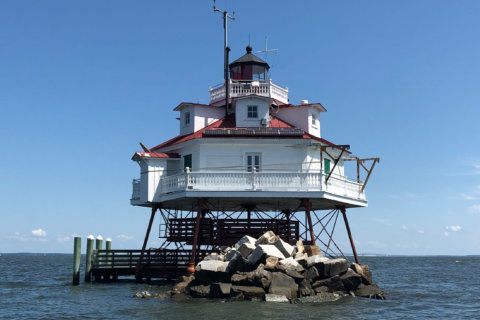This article was republished with permission from WTOP’s news partners at Maryland Matters. Sign up for Maryland Matters’ free email subscription today.
This content was republished with permission from WTOP’s news partners at Maryland Matters. Sign up for Maryland Matters’ free email subscription today.
On their 100th day in office on Friday, barrier-breaking Gov. Wes Moore (D) and Lt. Gov. Aruna Miller (D) will be where they have been a lot so far in their terms — on the road.
Between the two of them, the Moore-Miller team has been to every county in the state at least once since their inauguration on Jan. 18 (and Miller will have personally been to all 24 jurisdictions herself by the end of the day Friday, her staff said).
Moore has traveled as far out as Lonaconing, in Allegany County, marking the first time since 1996 that a sitting governor had visited the town.
“When I said we were going to represent the State of Maryland from the sandy beaches of the Eastern Shore to the rolling hills of Western Maryland, I meant it,” Moore said after the visit. “Our administration is going to raise the voices of all Marylanders, with the goal of creating a more competitive and equitable home for all.”
On Friday, Moore and Miller will, in fact, be together on the Eastern Shore, visiting Salisbury University and the Salisbury Regional Airport before meeting for a 100th-day celebratory lunch at Snapper’s Waterfront Cafe and Tiki Bar in Cambridge.
In brief comments about his first 100 days in office on Thursday, Moore said he was proud to have “changed the tenor” in Annapolis, focusing on working with legislators during his first General Assembly session.
Moore said each of the ten bills he sponsored passed with some bipartisan support — even if some of the measures were diluted versions of his initial proposals. Those bills included measures to accelerate the state’s move to a $15 minimum wage (lawmakers stripped a provision to index future increases with inflation), increase tax breaks for military retirees, and expand tax credits for low-income Marylanders.
The governor regularly invited lawmakers to Government House, hosting breakfasts for guests ranging from a couple of legislators to larger caucus groups.
“I think we’re showing there’s a new tenor of partnership in Maryland, that we can debate issues, yet at the same time, we can focus more on ‘Is it a good idea?’ than ‘Where did the idea come from?'” Moore said.
And perhaps most personally to the governor, he has attempted to cement in the first 100 days his reputation as the “service governor.” He signed into law this week a paid service-year option for Maryland high school graduates that will be guided by a new $18-million investment in the Department of Service and Civic Innovation.
Moore saw the confirmation of his full Cabinet — save for one member appointed after the legislative session ended — and has a budget that will guide state government in his mold beginning July 1.
Moore filled some campaign promises — to release funding to expand medical training for abortion providers — early in his term, but is still at work on others — the appointment of a climate czar to oversee policy efforts and placing his considerable assets in a blind trust to avoid conflicts of interest in governance. (A final trust agreement is expected to be announced in the near future.)
Asked about his assessment of any shortfalls at the start of the term, Moore was hard-pressed to come up with examples.
“I know that there are there are certain things that we are going to have that we will be pushing on, specifically when it comes to issues like crime and public safety, that I’m not waiting for the next legislative session in order to get the work done that needs to be done,” Moore said.
And while the governor’s first budget year was eased by a robust state funding surplus, he didn’t directly address whether the administration and lawmakers will need to soon seek new revenue streams or taxes to cover the programs and expansions being passed now.
“When it comes to how we present our budgets, we’re going to be data-driven, we’re going to focus on knowing that we can be bold and we can ambitious, but that does not mean we’re going to be reckless,” Moore said.
Advocacy groups offer assessments
During the legislative session that ended April 10, state Cabinet secretaries met with the legislative policy committee at the Maryland Association of Counties, a considerable lobbying force in Annapolis.
“We’re happy to see that the governor has taken a collaborative approach with MACo and with all of our counties,” said Kevin Kinally, the organization’s legislative director. ” … We feel connected and we feel like we’re being heard.”
Kinally said the Moore administration seems to value consensus, which is key to establishing his organization’s top priorities.
“They seem to understand that it’s really important to have broad stakeholder buy-in and they’ve been doing that from the get-go,” he said.
Maryland Municipal League CEO Theresa Kuhns said she’s been heartened by the appointment of former Hagerstown Mayor Emily Keller and former Salisbury Mayor Jake Day to key roles in the Moore-Miller administration.
“The governor calls it a partnership and he’s not just talking to talk, he’s walking the walk. He’s truly shown us that he wants to work with our cities and towns,” she said.
The Moore-Miller administration received praise from other advocacy groups in interviews over the past week.
“Gov. Moore has ensured he had the most diverse cabinet possible,” Gustavo Torres, executive director of CASA, said in an interview Wednesday. “It reflects who we are and our values in Maryland. That is going to set the tone for what we are going to see in the next few years.”
Torres lauded Moore’s support of an accelerated minimum wage increase and the Family Prosperity Act, which will permanently allow some undocumented immigrant families, previously excluded, to receive the state’s earned income tax credit.
“The tax credits are one of the most extraordinary tools to move people from poverty,” he said.
But Torres said his group is working with the administration to push for an executive order on health care legislation that didn’t pass in the Senate during this year’s 90-day legislation session.
House Bill 588 would’ve removed immigration status as an eligibility requirement to purchase a health plan through the Maryland Health Benefit Exchange.
Maryland Public Defender Natasha Dartigue said in an email Wednesday that she appreciated that the governor’s focus on public safety includes more than law enforcement.
“Gov. Moore understands that successful, collaborative efforts which improve public safety require input from the Office of the Public Defender, particularly in matters directly impacting poor and marginalized communities,” she said. “Importantly, the Governor has acknowledged, through OPD’s expanded budget, that criminal justice reform requires the existence of a robust public defense system that is supported through equitable resources and sustained through parity funding.”
Nancy Soreng, president of the League of Women Voters, praised the governor’s support of Speaker Adrienne Jones’s effort to enshrine abortion rights in the state Constitution and his push for additional money toward the Blueprint for Maryland’s Future Education reform plan.
But she said the governor “missed an opportunity” to advocate for the health care measure CASA pushed for.
Two other bills Soreng wished the governor would back that didn’t pass were the Youth Equity and Safety Act, which sought to allow some youth charged with crimes of violence to have those cases heard in juvenile court instead of going directly to adult court. The other piece of legislation, House Bill 562, would’ve established a $350 monthly housing allowance for some households receiving temporary cash assistance or other state support services.
“We hope that next session the Governor will champion more bills than just those that his office submits,” Soreng wrote in her email.
Climate and the environment
Environmentalists had high hopes for Moore even before he took office. The Maryland League of Conservation Voters gave Moore a key endorsement in the Democratic primary, and other environmental leaders, who were dispersed among the leading Democratic contenders, quickly fell in line for the general election.
During the campaign, Moore rolled out a comprehensive plan for fighting climate change, and staying on brand, largely discussed the issue through an equity lens. He also linked development of clean energy industries to his pledge to create more economic opportunities in struggling communities, as well as to offer a service year for recent high school graduates.
“This is going to inspire a generation of Marylanders actually to get in the trenches on the most pressing issues facing the state,” Moore told Maryland Matters in the fall of 2021, when his campaign was just a few months old. “I’m excited about how we can put them to work, installing solar panels on roofs, planting trees, taking the state’s goals and actually having an army that can accomplish them.”
Green leaders were also cheered by Moore’s early picks to head several key agencies, including the Maryland Department of the Environment, the Department of Natural Resources and the Maryland Energy Administration. Moore has signaled that he sees the Department of Transportation, the Department of Planning and the Department of Commerce as also being integral parts of the solution for combating climate change and promoting clean energy. And he has vowed to remake the Maryland Public Service Commission, which regulates gas and electric utilities in the state, to make the commission more proactive about climate change (one Moore nominee to the PSC, Juan Alvarado, drew the ire of environmentalists for his work in the natural gas industry, and he withdrew).
Beyond the controversy over Alvarado, environmentalists like what they’ve seen of Moore’s tenure so far — from his commitment to expanding offshore wind energy development to his support for measures to put as many electric vehicles on the road as possible, as quickly as possible.
Kim Coble, executive director of the Maryland League of Conservation Voters — who is co-chair of the Maryland Commission on Climate Change and was a leader of Moore’s climate transition team — said it’s “a new day for Maryland” on climate and the environment, thanks to Moore’s leadership and his ability to work with legislative leaders on mutual goals, something that didn’t exist when his predecessor, Republican Larry Hogan, was in office.
Former Gov. Parris Glendening (D), an ardent environmentalist and early supporter of Moore’s, said the governor is smart to hammer home the message that he’ll view every issue that comes to his desk through the lens of equity and climate impact.
“That reinforces that it’s not just about land use and planning,” Glendening said.
Moore’s approach has heartened Sarahia Benn, of the Policy Foundation of Maryland, a climate justice advocate who has been fighting noise and truck pollution from industrial operations and warehouses in her Harford County neighborhood for years. She called Moore’s embrace of stringent national standards for the sale of electric trucks “a game changer for my community because we’d move from having people experiencing negative health impacts to having a better quality of life.”
One environmental pledge that Moore has yet to fulfill is hiring a chief sustainability, mitigation and resilience officer — someone who, according to his campaign literature, would “ensure strong public-private collaboration, measure our progress and ensure accountability to our goals.”
Carter Elliot IV, a Moore spokesperson, said this week that the administration hopes to have someone in place soon, though there is no fixed timetable for filling the position.
Bryan P. Sears contributed to this report.







